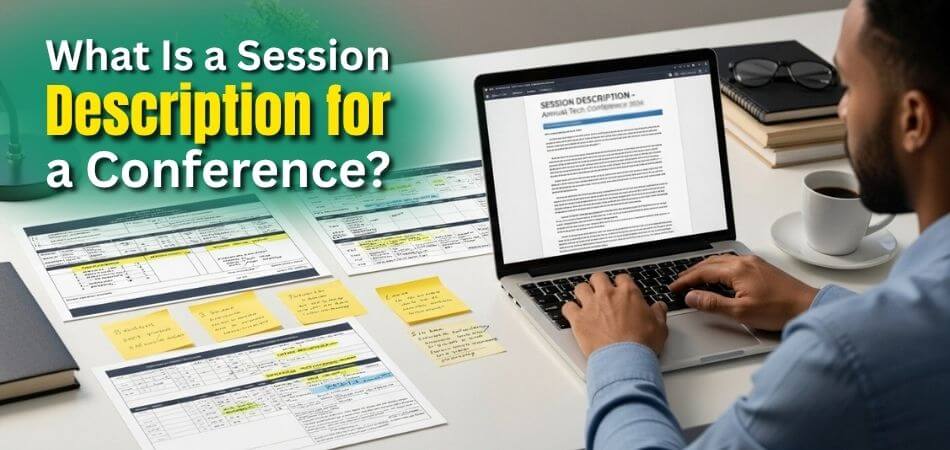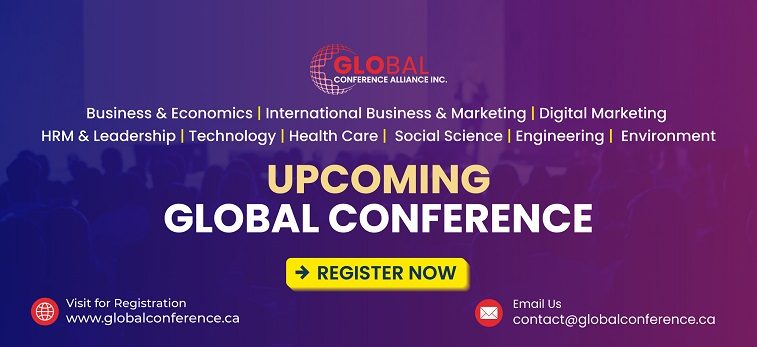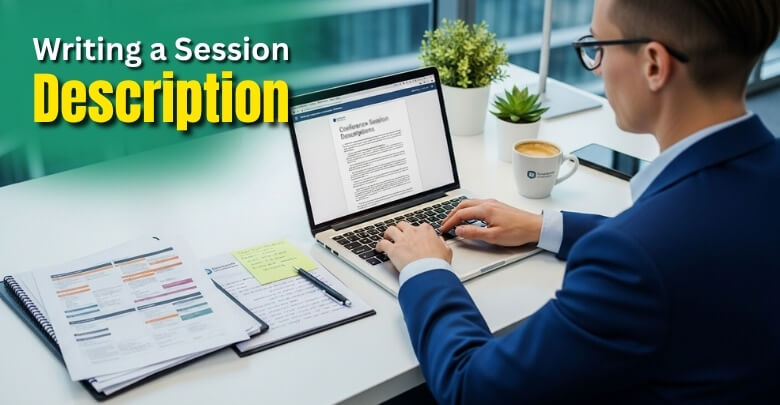Conferences can feel complicated with so many sessions, speakers, and activities happening at once. Attendees often depend on small but powerful details to decide where to spend their valuable time. That’s where session descriptions step in as a guiding tool.
So, what is a session description for a conference? In simple terms, it’s a short overview that explains what the session will cover, who it is for, and why it matters. It helps participants quickly decide if the session aligns with their interests or professional goals.
Beyond being a summary, a session description is also a promotional piece that attracts the right audience and sets clear expectations. Curious to learn how to write effective ones and avoid common mistakes? Keep reading as we explore the essentials step by step.
What Is a Session Description for a Conference?
A session description is a short overview that outlines the main theme and purpose of a conference session. It introduces the subject matter and helps readers understand the general focus of the discussion, presentation, or workshop.

In professional and academic settings, these descriptions work as informative summaries. They provide a clear picture of the session’s value, highlight its objectives, and signal why it may be relevant to participants. By doing so, they help position the session within the larger event.
Now that we understand what it is, let’s explore why conferences require clear session descriptions.
Helps Attendees Choose the Right Sessions
Clear descriptions give participants a way to filter options from multiple tracks. With many overlapping events in upcoming conferences, attendees rely on these short summaries to plan their time effectively. Without them, they risk missing sessions that match their goals and professional interests.
Provides Value to Organizers
For conference organizers, session descriptions strengthen event planning and marketing. They make it easier to promote sessions across brochures, websites, and apps. A clear and compelling description can draw larger audiences, highlight key themes of the event, and increase overall satisfaction among attendees.
Sets the Tone for Speakers
Speakers also benefit from well-prepared session descriptions. They serve as a roadmap that keeps presentations aligned with what was promised. This reduces confusion, enhances audience engagement, and ensures expectations are met, which contributes to a more professional and structured event experience.
Encourages Audience Engagement
When attendees know what to expect, they come prepared with relevant questions or insights. This preparation fosters interactive discussions, better networking, and more meaningful takeaways. A concise description acts as an invitation for dialogue, which is often one of the main goals of attending conferences.
A session description is more than just a summary; it is a strategic tool that benefits attendees, organizers, and speakers alike. By offering clarity, it ensures that conferences run smoothly and deliver the value participants expect.
The Role of a Session Description in Conference Programs
Session descriptions are central to how conferences communicate with attendees. They appear in brochures, schedules, and mobile apps, offering concise details that guide decision-making. Beyond helping individuals, they serve as organizational tools that streamline event management and enhance participant engagement from start to finish.
Placement in Brochures and Schedules
Session descriptions are key highlights in printed brochures and official schedules. They act as quick guides that allow attendees to navigate through multiple tracks. By summarizing each session clearly, organizers make it easier for participants to plan their day without confusion or wasted time.
Integration Into Online Platforms
Modern conferences rely on websites and apps to share event details. Session descriptions provide accessible snapshots that attendees can filter or search. This digital integration improves convenience, increases visibility of each session, and ensures participants can access accurate details wherever they are during the event.
Helps Organizers Categorize Sessions
For organizers, session descriptions make categorization simpler. Whether it’s dividing sessions by theme, audience, or expertise level, these summaries create order within complex programs. By grouping content effectively, they not only improve the flow of the schedule but also enhance promotional strategies across multiple channels.
Sets Expectations for Participants
Clear session descriptions prepare attendees by setting expectations early. Participants know what topics will be discussed, what benefits they’ll gain, and who will be speaking. This prevents misunderstandings, builds trust, and encourages more active engagement, ensuring the sessions align with what was promised in the program.
The role of a session description goes far beyond a short write-up. It connects the dots between organizers, speakers, and participants, ensuring the entire program runs smoothly and delivers value across every medium.
Key Elements That Make a Session Description Effective
An effective session description is more than just a summary; it’s a carefully crafted message that attracts the right audience. To achieve this, certain components must always be included. These elements ensure clarity, structure, and relevance, making the description both engaging and informative.
Title That Captures Attention
A strong session title is specific, clear, and compelling. For example, “Innovations in Sustainable Energy” instantly conveys focus, while “Energy Stuff” feels vague. Titles should be professional yet inviting, encouraging participants to explore further. The right choice sets the stage for engagement before attendees even read the details.
Concise and Clear Summary
The summary gives an overview of what the session will cover. Strong examples highlight key themes and benefits, such as “Learn practical steps for applying AI in marketing.” A weak version might simply say “Talk about AI.” Attendees value clarity, so keep the summary direct, specific, and informative.
Well-Defined Objectives
Objectives explain what participants will gain by attending. Effective objectives use action words like “understand,” “analyze,” or “apply.” For example, “Understand the impact of digital tools on customer behavior” is stronger than “Talk about customers.” Clear objectives not only guide attendees but also help organizers evaluate session relevance.
Audience Relevance
A good description specifies who the session is for—students, professionals, or researchers. For example, “Ideal for business leaders exploring growth strategies” signals relevance clearly. A weak description that says “for everyone” creates confusion. Targeting the right group ensures that attendees feel confident the session meets their needs.
Speaker Details
Including speaker names and expertise adds credibility. “Presented by Dr. Lee, author of ‘Future Trends in AI’” conveys authority and draws interest. A vague version like “Speaker: John” offers no context. Highlighting speaker achievements reassures attendees about the quality and builds trust in the session’s value.
By combining clear titles, focused summaries, defined objectives, audience relevance, and strong speaker details, session descriptions transform from simple write-ups into effective tools for engagement. Concise and informative language ensures they capture attention and guide participants toward the sessions most valuable to them.
How Long Should a Session Description Be?
A session description generally falls between 100 and 250 words, depending on the event’s rules. The aim is to inform clearly without overloading readers. Strong descriptions give just enough detail to highlight objectives and benefits while keeping the language simple, focused, and easy to understand. Aim for clarity and conciseness so your session description attracts attention instantly.
Conference Guidelines
Most conferences provide word count limits, often ranging from 100 to 250 words. Following these rules ensures your submission is accepted without extra editing. Keeping descriptions within the specified length also helps organizers maintain consistency across brochures, schedules, and online listings, which creates a more professional event presentation.
Communication Medium
The platform determines the ideal length. Printed brochures usually require shorter summaries, while websites and event apps allow longer descriptions. Adjusting your word count to fit the medium ensures maximum readability. Well-tailored content also improves visibility, making it easier for attendees to grasp the session’s purpose quickly.
Audience Attention Span
Attendees want clear, quick takeaways when reviewing multiple options. Overly long descriptions may feel overwhelming, while overly short ones risk leaving out key details. A balanced approach provides just enough information to highlight the session’s value, encouraging participants to choose confidently without feeling lost or misled by vague wording.
The right length is about delivering clarity, not filling space. Keep descriptions sharp, adaptable to different formats, and focused on value to ensure they resonate with both organizers and attendees.
Common Mistakes to Avoid in Writing Session Descriptions
Writing a session description seems simple, but small mistakes can reduce its impact. From unclear wording to unnecessary jargon, these errors confuse attendees and weaken interest. By knowing what to avoid, you can make your description both professional and engaging, ensuring better participation and organizer approval.
Avoid these common mistakes to create session descriptions that truly stand out.
Using Vague Language
Descriptions like “This session is about leadership” don’t tell attendees much. Vagueness creates confusion and weakens trust, causing some participants to consider skipping conference sessions even when the topic could be relevant. Instead, be specific: “Explore practical leadership strategies for managing remote teams.” Clear, direct wording shows value and helps participants decide whether the session aligns with their interests.
Excessive Technical Terms
Loading a description with technical terms alienates readers who may not share the same expertise. Jargon-heavy writing limits accessibility and lowers attendance. Replace complex language with simpler words. For example, say “tools for better project management” instead of “innovative operational synergies,” keeping it professional yet approachable.
Overly Promotional Tone
Making a description sound like an advertisement damages credibility. Phrases such as “the best session you’ll ever attend” distract from the real value. Attendees want clear takeaways, not hype. Instead, focus on outcomes, like “Gain strategies to streamline workflows,” which demonstrates benefits without exaggeration.
Leaving Out Objectives
Without clear objectives, participants don’t know what they’ll gain. This uncertainty discourages attendance and frustrates organizers. Always include learning goals, such as “Understand new trends in digital marketing” or “Learn how to apply data tools in research.” Objectives give direction and assure attendees that the session is worthwhile.
Avoiding vague, jargon-filled, or overly promotional descriptions ensures your content stays professional and engaging. By adding clear objectives, you create descriptions that both attract attendees and satisfy organizers, strengthening the overall quality of the conference program.
Best Practices for Writing a Session Description That Stands Out
Strong session descriptions grab attention quickly and motivate participation. The best ones are simple, clear, and value-driven. By applying a few proven practices, you can make your descriptions more engaging while ensuring they align with both the needs of attendees and the expectations of conference organizers, making a great conference session even more impactful.
Apply these best practices to create descriptions that inspire attendance and build trust.
Use Active Language
Active words make descriptions more lively and inviting. For instance, “Discover strategies to improve team collaboration” feels stronger than “Strategies will be discussed.” Active phrasing adds energy, keeps readers engaged, and helps highlight exactly what participants will gain from the session.
Highlight Benefits Clearly
Attendees want to know how the session helps them. Instead of focusing only on content, emphasize outcomes: “Learn how to streamline workflows for efficiency.” Highlighting benefits shows value immediately, making the description appealing and ensuring participants feel their time will be well spent.
Align With Conference Themes
Descriptions that connect to the overall event theme attract more attention. If the conference is about innovation, mention how the session contributes to this focus. Linking your session to broader goals builds relevance and strengthens its appeal across brochures, apps, and promotional materials.
Tailor for Formats
Adjust word choice and length depending on where the description appears. Printed brochures may need shorter, concise entries, while websites or apps can include more details. Tailoring ensures clarity and prevents overcrowding in any format, keeping the message professional and audience-friendly.
Quick Do’s and Don’ts
Do use simple, clear sentences and action words. Do highlight objectives and benefits in every description. Don’t exaggerate or use overly promotional claims. Don’t overload with jargon or irrelevant details. Following these rules makes your description both professional and appealing to the right audience.
By using active language, showcasing benefits, and adapting for different formats, you create session descriptions that stand out. Pairing these practices with simple do’s and don’ts ensures your descriptions remain professional, effective, and engaging across every platform.
Frequently Asked Questions
People often have small but important questions after learning about session descriptions. To make things easier, here are some common queries answered in a simple way. These will help you feel more confident about writing your own.
Can I Use Humor in a Session Description?
Yes, but only if it fits the conference tone. A light touch of humor can make your session more memorable. Avoid overdoing it, since professionalism must still come first.
Should I Include Keywords for Searchability?
Including relevant keywords is a smart idea, especially for online listings. It helps attendees find your session faster. Just keep the keywords natural, so the description still reads smoothly.
Do Session Descriptions Need Visual Elements?
Sometimes yes, if the platform allows it. Adding bullet points or bold words can improve readability. However, always keep the text itself clear, because many brochures and apps display plain text only.
How Early Should I Write My Session Description?
It’s best to prepare your session description early in the planning stage. This ensures organizers can use it in promotions. Early writing also gives you enough time to refine and edit.
Can I Reuse a Session Description for Different Conferences?
You can, but it’s better to adapt. Each conference has a unique audience and theme. Tailoring your description makes it more relevant and improves your chance of attracting attendees.
Should I Mention Learning Materials or Handouts?
Yes, if you plan to provide them. Including details about materials or resources gives your session extra appeal. Attendees appreciate knowing they’ll leave with something useful for later reference.
What If I Am Not Good at Writing?
You don’t need to be a professional writer. Focus on clarity and honesty about what your session offers. You can also ask a colleague to review and polish your draft.
Concluding Words
Understanding what makes a session description effective is important for both organizers and participants. It helps events run smoothly and ensures that everyone knows what to expect before choosing where to spend their time.
If you’ve been wondering what is a session description for a conference, the answer is simple: it’s a clear, short summary that highlights the session’s purpose, goals, and audience. When written well, it becomes a strong tool to guide decisions and spark interest.
The best session descriptions are concise, focused, and engaging. They connect attendees with the sessions most relevant to them and support organizers in building successful programs. Keep these tips in mind as you prepare your next conference description, and you’ll create real value for your audience.








